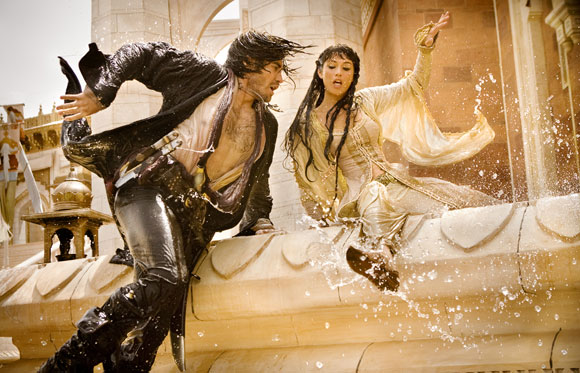Prince of Persia: The Sands of Time

PRINCE OF PERSIA: THE SANDS OF TIME. (L-R) Jake Gyllenhaal, Gemma Arterton. Photo: Andrew Cooper, SMPSP

A street orphan with some acrobatic skill, Dastan (William Foster; Jake Gyllenhaal), resists a bully of a guard in the service of King Sharaman (Ronald Pickup). Seeing his noble deed, the King adopts Dastan as his own. Avoiding the opportunity to build up the audience’s sense of myth, the film skips ahead fifteen years to the Royal City of Alamut, invaded under dubious pretense—supposedly stockpiling weapons from the King’s city of Nasaf. Upon conquering the city, Dastan’s brother Tus (Richard Coyle) gives him a prayer robe with which to adorn their father during a ceremony. The cloak, as it turns out, is poisoned and Dastan, despite all appearances to the contrary, is blamed for King Sharaman’s death.
While there did exist an Alamut in the Persian Empire, that’s essentially where the historical similarities end and begins yet another in a seemingly endless series of video game adaptations—this one requiring three screenwriters. And I’m not sure why, either. Combine Stephen Sommers’ The Mummy (1999) with Disney’s Aladdin and you have the story, the plot and the action. A sacred object, the Dagger of Time, must be returned to its rightful place or the world will fall to ruin. This is a special dagger which has the ability to rewind time, conveniently enough for only one minute. Does it rewind time everywhere? What are the implications of doing so? Never mind. This isn’t the sort of film to inspire even shallow thoughts.
Enter the beautiful princess, Tamina (Gemma Arterton), who is sworn to protect the Dagger. In the tradition of other female adventure sidekicks of late (Keira Knightley in the Pirates of the Caribbean films, Rachel Weisz in the Mummy franchise), she is feisty, independent and British. Also, she inevitably will fall for Prince Dastan. The plot mostly involves the heroine and hero criss-crossing paths in one kerfluffle after another, out of which one helps the other, only to be double-crossed.
The film begins with horribly edited action sequences set in Alamut. The CG is a bit disorienting, as is the lack of coordinating proper entry-exit angles of action from one cut to the next. When Dastan is looking at an item he might be able to use as a weapon, the camera cuts from a medium shot of his face to a close-up of the object. Without the benefit of a wide shot, we can’t tell where in space the object is in relation to him. Likewise, entrances and exits through city streets and buildings are slapped together with little regard for how audiences need to perceive continuous motion in the same direction. This renders whole action scenes chaotic. But the editors seem to get a better footing in the second and third acts approaching the climactic battles between Dastan and a band of Hassansins—creepy fellow in black, quite handy with blades.
Richard Coyle, most known for his comedic role as Jeff Murdoch in the BBC serial Coupling, proves quite capable of being taken seriously as the heir apparent to the throne. As his advisor, Nizam (Ben Kingsley) mostly scowls through that penciled goatee, far too loudly echoing the Grand Vizier Jafar from the aforementioned Aladdin. In keeping with the lighthearted adventure formula, comic relief enters the third act in the form of Alfred Molina as Sheikh Amar. Now I begin to wonder, why all the British actors? It’s been a tradition in Hollywood epics to do Brit accents as the de facto standard of any place that wasn’t America. My guess is that someone figured out well before George Lucas that English accents can convincingly deliver terrible dialogue. (A simpler explanation: Director Mike Newell is from the UK, and the set pieces were filmed at Pinewood Studios.) To further remove us from history, everyone is a King, Prince or Princess… except for Alfred Molina. He’s got the only middle-Eastern title. Wouldn’t Shahzadeh Dastan sound much better (even if it doesn’t make sense, literally translating to “Prince story”)? I know. That’s not really the point, but it’s amusing nonetheless.
The fundamental problem, as with all time-twisting adventures, is that while earlier action introduces an element of suspense, it quickly wears off the third or fourth time Dastan is able to rewind the clock. We can’t feel any sense of real peril for any of the characters when at any moment the sands of time can be shifted backward. A forgettable entertainment that might be worth a matinee if you can’t think of anything else to do… laundry, for example.
 Prince of Persia: The Sands of Time • Dolby® Digital surround sound in select theatres • Aspect Ratio: 2.39:1 • Running Time: 116 minutes • MPAA Rating: PG-13 for intense sequences of violence and action. • Distributed by Walt Disney Studios Motion Pictures
Prince of Persia: The Sands of Time • Dolby® Digital surround sound in select theatres • Aspect Ratio: 2.39:1 • Running Time: 116 minutes • MPAA Rating: PG-13 for intense sequences of violence and action. • Distributed by Walt Disney Studios Motion Pictures